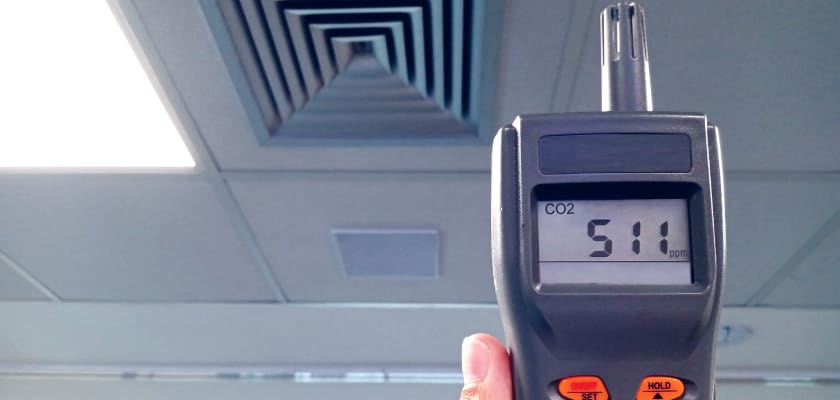Workplace air sampling FAQ: What Ontario employers need to know

Workplaces that use hazardous chemicals are required to carry out air sampling under Regulation 833, Control of Exposure to Biological or Chemical Agents to ensure workers are not exposed to hazardous substances above the occupational exposure limits (OELs). If exposures are over the limits, the law requires workplaces to put additional control measures in place to reduce worker exposures.
Until March 31, 2026, occupational hygiene Inspectors from the Ministry of Labour, Immigration, Training and Skills Development (MLITSD) are visiting workplaces to ensure they comply with Regulation 833. “If your workers are exposed to hazardous chemicals, and you haven’t carried out air sampling at all, or done so recently, you need to take action,” says Toni Volpato, WSPS Specialized Consultant (Occupational Hygiene).
Air sampling is key to understanding how much hazardous chemicals workers are breathing in during their workday. This information is critical in protecting workers from occupational diseases, which are the leading cause of worker deaths in Ontario, says Toni. According to the MLITSD, 69% of allowed fatality claims between 2020 and 2024 were due to occupational disease.
“The air sampling must be performed by, or under the direction of, a person who is qualified because of knowledge, training and experience in industrial hygiene practice, such as an occupational hygienist with a CIH or ROH designation,” notes Toni. Businesses that lack the technical expertise to carry out air sampling can turn to WSPS for help. “WSPS can carry out the air sampling for you, determine if levels are over the OELs, and help you select controls to reduce harmful exposures,” says Toni.
What can you expect during the WSPS air sampling process? Toni shares the details in the Q&A below.
Air sampling FAQ
1. What is the purpose of air sampling?
“Air sampling allows employers to determine the concentration of hazardous substances in the air that workers would be breathing in,” explains Toni. “This determines if employers are in compliance with Regulation 833 or if they are exceeding the occupational exposure limits (OELs) and by how much. This information, in turn, will help employers understand if their current control measures are sufficient or not. You may need to add additional controls to adequately protect your workers.”
2. What are occupational exposure limits (OELs)?
OELs are the maximum allowable concentration of a hazardous substance in the workplace, set by various professional organizations and government bodies. They are usually expressed in units such as ppm (parts per million) or mg/m³ (milligrams per cubic meter). In Ontario, the OELs can be found on the MLITSD website: Current occupational exposure limits for Ontario workplaces under Regulation 833 | ontario.ca
3. What is the first step in the air sampling/assessment process?
The first step is to understand what hazardous chemicals are being used in the workplace and who could be exposed,” says Toni. “A WSPS occupational hygienist can do an in-person walkthrough of your workplace and review your Safety Data Sheets (SDS) to identify the hazardous chemicals. We can also connect virtually as well to discuss processes where risks may be present that produce hazardous particulates, fumes, vapours and gases.”
During the walkthrough, the occupational hygienist gathers information on a variety of things, including:
- tasks being performed
- hazardous products used
- the way products are stored, handled and disposed
- how much and often the chemical is used
- likelihood and frequency of exposure
- who is exposed
- current controls in place
The Safety Data Sheet (SDS) that accompanies each hazardous product provides important information on health hazards and required safety precautions for handling, storing, and disposing of the chemicals,” says Toni. “It also outlines the likely routes of exposure (inhalation, ingestion, skin and eye contact), exposure symptoms, immediate and chronic effects of short-term and long-term exposure, along with first aid measures.
“Sections 3 and 8 of the SDS provide details of the hazardous ingredients. The occupational hygienist can determine if there is an OEL for these ingredients, cross-referencing the product’s Chemical Abstract Service (CAS) number to ensure an exact match. Now, we can begin the sampling strategy,” notes Toni.
4. What does air sampling involve?
Air samples are collected from the worker’s breathing zone using a variety of sampling methods. The occupational hygienist will work with the employer and the laboratory that will process the results to determine what, where, who, how and when to sample, as well as how long to sample.
The sampling strategy is shared with the JHSC. “A worker member of the JHSC is always invited to be present at the beginning of the air testing to ask any questions and provide input,” notes Toni.
5. Will air sampling disrupt my workforce or production?
While workers may need to wear a sampling pump on their belt or a passive monitor on their shirt collar to gather a representative air sample, the disruption should be minimal, says Toni. “The pump and monitor are easy to use and should not interfere with your workers’ daily routine. We want the worker to carry out their tasks just as they would if they were not wearing the sampling equipment.”
Good communication among all parties – the occupational hygienist, the employer, the JHSC and the workers wearing the sampling equipment – is very important, notes Toni. “Everyone needs to understand what the employer wants to sample for, and why. We encourage people to ask questions to ensure a smooth day of air sampling.”
6. What happens to the samples?
Once the sampling is done, the collection media is sealed and sent to a lab, says Toni. There, the trapped chemicals are extracted and analyzed to provide a concentration of exposure.
“The lab results will tell us if people are overexposed or not. If they are, we provide recommendations on what additional controls may be necessary to reduce worker exposures below the OELs.”
7. How do you determine additional controls?
“We use the hierarchy of controls when considering additional controls, explains Toni. The hierarchy lists control methods from most effective to least effective: elimination, substitution, engineering controls, administrative/awareness controls, and personal protective equipment (PPE). For example, we might recommend putting local exhaust ventilation for welders to use, which is an engineering control.
In some cases, when additional controls are not feasible, we may recommend the use of respirators. If employers provide respirators for their workers to wear, they are required by law to do fit testing to ensure the respirator fits properly and implement a respiratory protection program. WSPS can also help with all of these things.
8. Who should you share the recommendations with?
The report of the results and recommendations is reviewed with the employer and should be shared with the JHSC and the workers who participated in the air sampling. It is also good to post the report on the workplace’s Health and Safety Board for everyone to review if interested.
How WSPS can help
Consulting
Contact a WSPS occupational hygiene consultant to conduct air sampling and assist with your respirator protection program development to ensure you are compliant with the legislation.
Free resources and support
- MLITSD Occupational Hygiene Toolkit
- Use chemicals in your workplace? Get prepared for MLITSD inspections (article)
- Air Assessments: What Are They & MLITSD Campaign Compliance (pre-recorded webinar)
- Burning Questions: Managing Flammable & Combustible Liquids (pre-recorded)
- Preparing for a Ministry of Labour, Immigration, Training and Skills Development Inspection
- What to expect when a Ministry inspector comes to your workplace (article)
- WHMIS Regulation 860 and 833 Compliance Checklist
- Workbook for Designated Substance Assessments
- Silica in the Workplace (guide)
- Chemical Safety for Small Business (video)
Training
- Designated Substances Awareness (eCourse, 1.5 hours)
- WHMIS Training for Workers (Instructor-led, 3.5 hours)
- WHMIS Awareness for Agriculture (2 hours)
- WHMIS Online Training (eCourse, 1.5 hours)
- Compressed Gases (eCourse, 1.5 hours)
The information in this article is accurate as of its publication date.




